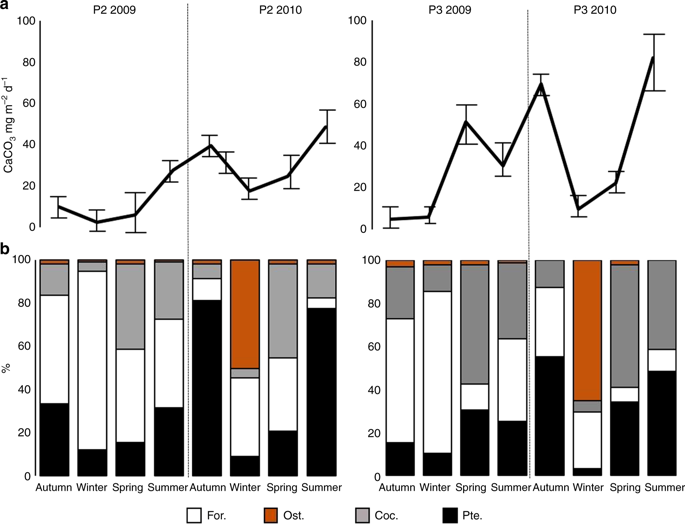当前位置:
X-MOL 学术
›
Nat. Commun.
›
论文详情
Our official English website, www.x-mol.net, welcomes your
feedback! (Note: you will need to create a separate account there.)
Threatened species drive the strength of the carbonate pump in the northern Scotia Sea.
Nature Communications ( IF 14.7 ) Pub Date : 2018-11-02 , DOI: 10.1038/s41467-018-07088-y C. Manno , F. Giglio , G. Stowasser , S. Fielding , P. Enderlein , G. A. Tarling
Nature Communications ( IF 14.7 ) Pub Date : 2018-11-02 , DOI: 10.1038/s41467-018-07088-y C. Manno , F. Giglio , G. Stowasser , S. Fielding , P. Enderlein , G. A. Tarling

|
The efficiency of deep-ocean CO2 sequestration is regulated by the relative balance between inorganic and organic carbon export respectively acting through the biological carbon pump (BCP) and the carbonate counter pump (CCP). The composition and abundance of calcifying species in the prevailing oceanic plankton community plays a major role in driving the CCP. Here we assess the role of these calcifying organisms in regulating the strength of the CCP in a Southern Ocean region (northern Scotia Sea) known to be a major hotspot for the drawdown of atmospheric CO2. We show that, when shelled pteropods dominate the calcifying community, the total annual reduction of CO2 transferred to the deep ocean doubles (17%) compared to when other plankton calcifiers dominate (3-9%). Furthermore, predation enhances their contribution through the removal of organic soft tissue. Pteropods are threatened in polar regions by ocean warming and acidification. We determine that their potential decline would have major implications to the comparative strengths of the BCP and CCP.
中文翻译:

受威胁的物种驱动着斯科舍海北部碳酸盐泵的强度。
通过分别通过生物碳泵(BCP)和碳酸盐反向泵(CCP)起作用的无机和有机碳输出之间的相对平衡,来调节深海CO 2隔离的效率。盛行的海洋浮游生物群落中钙化物种的组成和丰富度在推动CCP方面发挥着重要作用。在这里,我们评估了这些钙化生物在调节南部海洋地区(斯科舍海北部)的CCP强度中的作用,该地区是大气CO 2吸收的主要热点。我们表明,当带壳的翼足类动物在钙化群落中占主导地位时,CO 2的年度总减少量与其他浮游生物钙化剂占主导地位(3-9%)相比,转移到深海的数量增加了一倍(17%)。此外,捕食通过去除有机软组织增强了它们的贡献。海洋变暖和酸化作用使极地地区的翼足类受到威胁。我们确定,它们的潜在下降将对BCP和CCP的相对优势产生重大影响。
更新日期:2018-11-05
中文翻译:

受威胁的物种驱动着斯科舍海北部碳酸盐泵的强度。
通过分别通过生物碳泵(BCP)和碳酸盐反向泵(CCP)起作用的无机和有机碳输出之间的相对平衡,来调节深海CO 2隔离的效率。盛行的海洋浮游生物群落中钙化物种的组成和丰富度在推动CCP方面发挥着重要作用。在这里,我们评估了这些钙化生物在调节南部海洋地区(斯科舍海北部)的CCP强度中的作用,该地区是大气CO 2吸收的主要热点。我们表明,当带壳的翼足类动物在钙化群落中占主导地位时,CO 2的年度总减少量与其他浮游生物钙化剂占主导地位(3-9%)相比,转移到深海的数量增加了一倍(17%)。此外,捕食通过去除有机软组织增强了它们的贡献。海洋变暖和酸化作用使极地地区的翼足类受到威胁。我们确定,它们的潜在下降将对BCP和CCP的相对优势产生重大影响。





















































 京公网安备 11010802027423号
京公网安备 11010802027423号